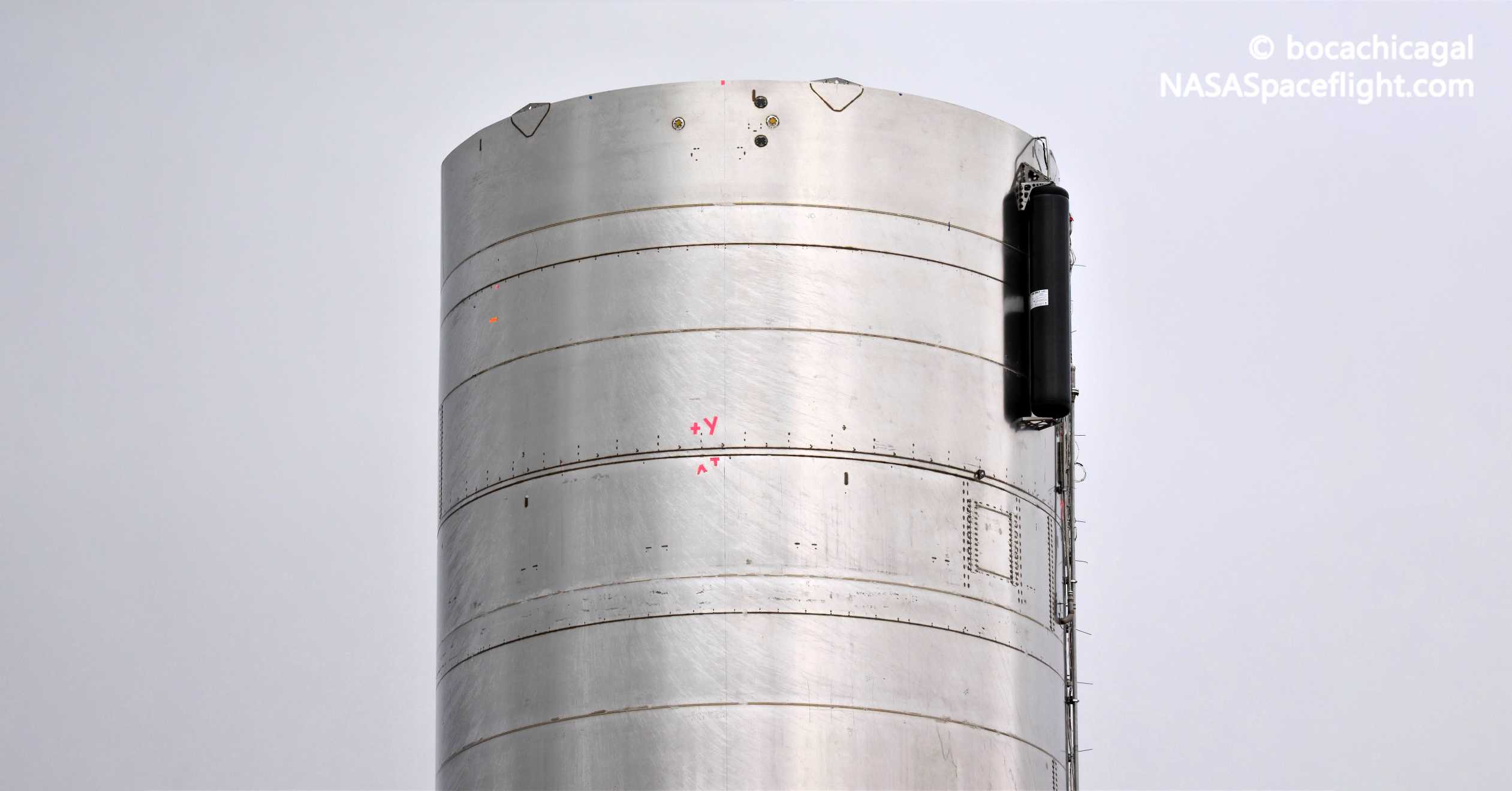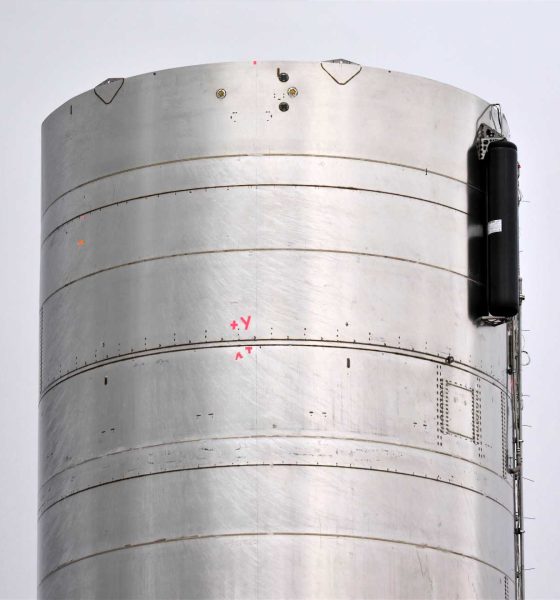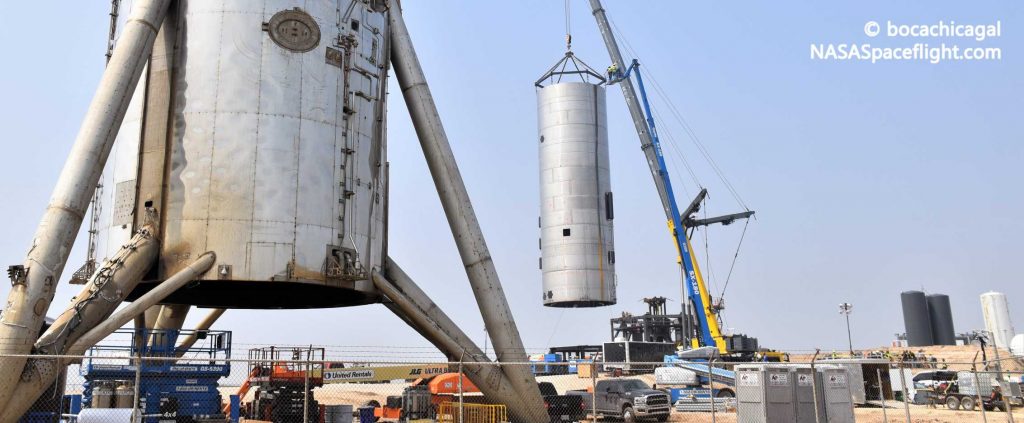

News
A SpaceX Starship rocket could take to the sky for the first time later this week
SpaceX has scrubbed its latest Starship static fire test for the third time since Friday but if another attempt succeeds within the next few days, a full-scale Starship prototype could lift off for the first time later this week.
SpaceX has attempted to perform a Starship static fire every day for the last three days without any luck, foiled by what must be mild technical issues and some extreme South Texas weather. That static fire – set to be Starship serial number 4’s (SN4) third – is required because SpaceX chose to replace the rocket’s installed Raptor engine (SN18) around 10 days ago after completing two successful tests on May 4th and 5th. Installed a few days after SN18 was removed, Starship and Raptor SN20 must now perform their own integrated static fire to ensure the complex systems are working properly.
Since SN4’s last test, SpaceX teams have been swarming the Starship prototype day and night, installing new COPVs (composite overwrapped pressure vessels; used to store high-pressure gas), new plumbing, and more. The specific purposes of all those in-situ changes can only be speculated at but what is clear is that SpaceX is preparing Starship SN4 for the first attempted flight test of a full-scale prototype, following in the footsteps of Starhopper’s bizarre but successful July and August 2019 hops. As SN4’s third Raptor static fire has slipped, though, so has that flight test. While the FAA has yet to officially publish a license for the 150m (~500 ft) Starship hop, NOTAMs (Notices to Airmen) filed recently suggest that that license and hop could come any day now.
Most recently, a NOTAM was filed on May 18th for what is likely Starship’s 150m hop test on Thursday, May 21st. Filed before SN4’s May 18th static fire test was aborted twice, that proposed May 21st hop test will almost certainly be delayed at least as long as the static fire that needs to precede it and is also dependent upon the FAA officially licensing the flight. The fact that NOTAMs are being filed for that flight strongly suggests that SpaceX and the FAA or in the late stages of hammering out a license, a process that can often involve a great deal of back-and-forth and compromise for experimental rocket launches.
Regardless, if or when Starship SN4 finally manages to fire up its new Raptor engine, it could be just a matter of days after that SpaceX attempts the first true Starship flight test. If everything goes according to plan, the ~30m (~100 ft) tall stainless steel rocket will lift off under the power of a single asymmetrically installed Raptor engine, capable of producing up to 200 metric tons (~450,000 lbf) of thrust with cryogenic liquid methane and oxygen propellant.

After lifting off from its ad-hoc South Texas launch mount, Starship SN4 will attempt to reach a peak altitude of 150m (~500 ft) and descend back down for a soft landing on an adjacent concrete pad, just like Starhopper did around nine months ago. A lot could go wrong: aside from using steel more than three times thinner than Starhopper’s, Starship SN4 will also be debuting an entirely new kind of landing leg, will be flying with asymmetric thrust, and will likely be using autogenous pressurization — all new challenges for SpaceX.
Nevertheless, there are also reasons for confidence. SpaceX has already successfully pressurized Starship SN4 all the way to 7.5 bar (~110 psi, sufficient for uncrewed orbital flight), performed multiple wet dress rehearsals and two Raptor static fire tests, and even tested what appears to be a new kind of cold gas thruster needed for roll control. Most importantly, even if Starship SN4 is destroyed during its next static fire or inaugural flight attempt, Starship SN5 is nearly at the same stage of completion and should be ready to take the reins almost immediately after the potential demise of its predecessor. With Crew Dragon’s inaugural NASA astronaut launch scheduled on May 27th, the rest of the month is set to be quite the event.

Elon Musk
Elon Musk’s X will start using a Tesla-like software update strategy
The initiative seems designed to accelerate updates to the social media platform, while maintaining maximum transparency.

Elon Musk’s social media platform X will adopt a Tesla-esque approach to software updates for its algorithm.
The initiative seems designed to accelerate updates to the social media platform, while maintaining maximum transparency.
X’s updates to its updates
As per Musk in a post on X, the social media company will be making a new algorithm to determine what organic and advertising posts are recommended to users. These updates would then be repeated every four weeks.
“We will make the new 𝕏 algorithm, including all code used to determine what organic and advertising posts are recommended to users, open source in 7 days. This will be repeated every 4 weeks, with comprehensive developer notes, to help you understand what changed,” Musk wrote in his post.
The initiative somewhat mirrors Tesla’s over-the-air update model, where vehicle software is regularly refined and pushed to users with detailed release notes. This should allow users to better understand the details of X’s every update and foster a healthy feedback loop for the social media platform.
xAI and X
X, formerly Twitter, has been acquired by Elon Musk’s artificial intelligence startup, xAI last year. Since then, xAI has seen a rapid rise in valuation. Following the company’s the company’s upsized $20 billion Series E funding round, estimates now suggest that xAI is worth tens about $230 to $235 billion. That’s several times larger than Tesla when Elon Musk received his controversial 2018 CEO Performance Award.
As per xAI, the Series E funding round attracted a diverse group of investors, including Valor Equity Partners, Stepstone Group, Fidelity Management & Research Company, Qatar Investment Authority, MGX, and Baron Capital Group, among others. Strategic partners NVIDIA and Cisco Investments also continued support for building the world’s largest GPU clusters.
News
Tesla FSD Supervised wins MotorTrend’s Best Driver Assistance Award
The decision marks a notable reversal for the publication from prior years, with judges citing major real-world improvements that pushed Tesla’s latest FSD software ahead of every competing ADAS system.

Tesla’s Full Self-Driving (Supervised) system has been named the best driver-assistance technology on the market, earning top honors at the 2026 MotorTrend Best Tech Awards.
The decision marks a notable reversal for the publication from prior years, with judges citing major real-world improvements that pushed Tesla’s latest FSD software ahead of every competing ADAS system. And it wasn’t even close.
MotorTrend reverses course
MotorTrend awarded Tesla FSD (Supervised) its 2026 Best Tech Driver Assistance title after extensive testing of the latest v14 software. The publication acknowledged that it had previously criticized earlier versions of FSD for erratic behavior and near-miss incidents, ultimately favoring rivals such as GM’s Super Cruise in earlier evaluations.
According to MotorTrend, the newest iteration of FSD resolved many of those shortcomings. Testers said v14 showed far smoother behavior in complex urban scenarios, including unprotected left turns, traffic circles, emergency vehicles, and dense city streets. While the system still requires constant driver supervision, judges concluded that no other advanced driver-assistance system currently matches its breadth of capability.
Unlike rival systems that rely on combinations of cameras, radar, lidar, and mapped highways, Tesla’s FSD operates using a camera-only approach and is capable of driving on city streets, rural roads, and freeways. MotorTrend stated that pure utility, the ability to handle nearly all road types, ultimately separated FSD from competitors like Ford BlueCruise, GM Super Cruise, and BMW’s Highway Assistant.
High cost and high capability
MotorTrend also addressed FSD’s pricing, which remains significantly higher than rival systems. Tesla currently charges $8,000 for a one-time purchase or $99 per month for a subscription, compared with far lower upfront and subscription costs from other automakers. The publication noted that the premium is justified given FSD’s unmatched scope and continuous software evolution.
Safety remained a central focus of the evaluation. While testers reported collision-free operation over thousands of miles, they noted ongoing concerns around FSD’s configurable driving modes, including options that allow aggressive driving and speeds beyond posted limits. MotorTrend emphasized that, like all Level 2 systems, FSD still depends on a fully attentive human driver at all times.
Despite those caveats, the publication concluded that Tesla’s rapid software progress fundamentally reshaped the competitive landscape. For drivers seeking the most capable hands-on driver-assistance system available today, MotorTrend concluded Tesla FSD (Supervised) now stands alone at the top.
News
Elon Musk’s Grokipedia surges to 5.6M articles, almost 79% of English Wikipedia
The explosive growth marks a major milestone for the AI-powered online encyclopedia, which was launched by Elon Musk’s xAI just months ago.

Elon Musk’s Grokipedia has grown to an impressive 5,615,201 articles as of today, closing in on 79% of the English Wikipedia’s current total of 7,119,376 articles.
The explosive growth marks a major milestone for the AI-powered online encyclopedia, which was launched by Elon Musk’s xAI just months ago. Needless to say, it would only be a matter of time before Grokipedia exceeds English Wikipedia in sheer volume.
Grokipedia’s rapid growth
xAI’s vision for Grokipedia emphasizes neutrality, while Grok’s reasoning capabilities allow for fast drafting and fact-checking. When Elon Musk announced the initiative in late September 2025, he noted that Grokipedia would be an improvement to Wikipedia because it would be designed to avoid bias.
At the time, Musk noted that Grokipedia “is a necessary step towards the xAI goal of understanding the Universe.”
Grokipedia was launched in late October, and while xAI was careful to list it only as Version 0.1 at the time, the online encyclopedia immediately earned praise. Wikipedia co-founder Larry Sanger highlighted the project’s innovative approach, noting how it leverages AI to fill knowledge gaps and enable rapid updates. Netizens also observed how Grokipedia tends to present articles in a more objective manner compared to Wikipedia, which is edited by humans.
Elon Musk’s ambitious plans
With 5,615,201 total articles, Grokipedia has now grown to almost 79% of English Wikipedia’s article base. This is incredibly quick, though Grokipedia remains text-only for now. xAI, for its part, has now updated the online encyclopedia’s iteration to v0.2.
Elon Musk has shared bold ideas for Grokipedia, including sending a record of the entire knowledge base to space as part of xAI’s mission to preserve and expand human understanding. At some point, Musk stated that Grokipedia will be renamed to Encyclopedia Galactica, and it will be sent to the cosmos.
“When Grokipedia is good enough (long way to go), we will change the name to Encyclopedia Galactica. It will be an open source distillation of all knowledge, including audio, images and video. Join xAI to help build the sci-fi version of the Library of Alexandria!” Musk wrote, adding in a later post that “Copies will be etched in stone and sent to the Moon, Mars and beyond. This time, it will not be lost.”








